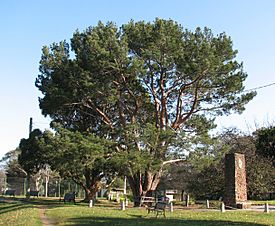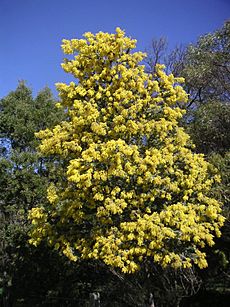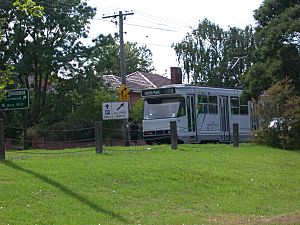Wattle Park, Melbourne facts for kids
Quick facts for kids Wattle Park |
|
|---|---|

Wattle Park's Lone Pine
|
|
| Location | Melbourne, Australia |
| Operated by | Parks Victoria |
| Paths | Pedestrian and bicycle access throughout |
| Facilities | Toilets, barbecues, playground, golf course |
Wattle Park is a cool public park in Melbourne, Australia. You can find it in the suburb of Burwood. It's famous for having over 12,000 wattle trees! Parks Victoria takes care of the park today. It's a great spot for outdoor fun, sports, and even special events like weddings.
Contents
Fun Things to Do at Wattle Park
Wattle Park is about 13 kilometers east of Melbourne's city center. It's located in the suburb of Burwood. The park has lots of awesome things for families and friends to enjoy.
You'll find two playgrounds for kids to have a blast. There are also BBQs, tables, and seats for picnics. Two old "W" Class trams are even used as cool shelters!
The Wattle Park Chalet is a special building inside the park. It has been a popular place for weddings and events since 1928. Some people say it's the oldest wedding venue in Melbourne that's still running! You can find public toilets near the Chalet.
If you love sports, there's a big grassy oval for games. There's also a nine-hole public golf course with a cafe. You can even book public tennis courts. The park has many walking tracks through the bush. There's also a path around the edge of the park. You can bring your dog, but make sure it's on a leash!
The Wattle Park Chalet Building
The Wattle Park Chalet was built in 1928. It was first used as a tea-house and a place for events. The building looks elegant with a rustic Tudor style. This style is similar to designs by a famous English architect, Sir Edwin Lutyens.
A Melbourne architect named Alan Monsborough designed the Chalet. It sits right in the middle of Wattle Park. Did you know that parts of the Chalet were recycled? The wooden beams came from older buildings. The roof slates were from a place called the former Yarra Bend Asylum. Even the bricks came from old tram engine-house chimneys! A front porch was added to the Chalet in 1937.
The Chalet has two smaller sections that branch off its main hall. The west side used to be where the caretaker lived. The east side had the kitchen and a small shop. Between these sections was a paved area. The paving stones were also recycled from old tramway buildings.
The Lone Pine Tree and History
About one-third of Wattle Park is a special heritage site. This means it's protected because of its history. The National Trust of Australia has also recognized the park as important.
One of the most famous trees in the park is the "Lone Pine". It's near the main carpark. This tree is very special because it's one of the few original Lone Pines in Australia. It grew from a seed collected during World War I. An Australian soldier found a cone from a lone pine tree in Gallipoli, Turkey. He brought it home as a reminder of the brave ANZACs and the Gallipoli Campaign.
The Lone Pine in Wattle Park was planted on May 8, 1933. It was part of a special ceremony by the 24th Battalion. This tree was the first Lone Pine ever planted publicly as an ANZAC memorial. It was planted a month before the one at Melbourne's Shrine of Remembrance. It was also planted 17 months before the one at the Australian War Memorial in Canberra!
Amazing Plants and Animals
Wattle Park has areas of native bushland. These areas are very important for the local environment. Experts have said the park is significant because it has many different native animals living in a suburban area.
You can find at least twenty kinds of butterfly here. There are also sixty types of beetles! Look out for three kinds of frogs, bats, and skinks. You might even spot ringtail and brushtail possums climbing in the trees. The park is also home to many birds. These include kookaburras, rosellas, rainbow lorikeets, galahs, and gang-gang cockatoos.
How Wattle Park Started
Wattle Park was created a long time ago. In 1917, the Hawthorn Tramway Trust (HTT) bought a large piece of land from Eliza Welch. The deal was that the land had to be used as a public park. This land used to be the home of Cr. Orlando Fenwick, who was once the Lord Mayor of Melbourne. People called it Fenwick's Paddock.
The park officially opened on March 31, 1917. Sir Arthur Stanley planted a Golden Wattle tree and gave the park its name.
At first, the HTT had money problems, so they couldn't develop the park much. Later, the HTT joined with the Melbourne and Metropolitan Tramways Board. Work on the park was delayed again because they were busy electrifying Melbourne's tramways.
Planning and building for the park really started in the 1920s and 1930s. Between 1926 and 1928, 12,000 wattle trees were planted! They were arranged in a wide belt around the park's edges. Lawns and flower beds were added. Winding paths were built. A small stream was cleaned and made wider. It was lined with willow and poplar trees. On the north-eastern slopes, a beautiful natural forest was kept safe. This forest had poplars, gums, and eucalyptus trees.
The Wattle Park Chalet was finished in 1928. It had a cafe, a dance floor, and other fun things. It was a tea house for snacks and fun, and a pretty place for weddings. Many parts of the Chalet were made from recycled materials. Bricks from old tramway chimneys were used. The roof had slates from the old Yarra Bend Asylum. Wooden beams came from old tram sheds. Even the paving in front of the Chalet was made from broken slates from old tramway engine houses.
Fencing posts around the park were made from old tramway rails. A children's "joy wheel" was made from an old tramway cable wheel! The Chalet was built on the highest point in the park. From its balconies, you could see amazing views of Melbourne. Playgrounds for children were set up with swings and other attractions. Old cable car dummies were turned into shelters. A sports oval and two tennis courts were also built. There was even a small lake with water lilies and goldfish! This lake used to be a dam for the old homestead.
A nine-hole golf course opened at Wattle Park in October 1937. Other facilities were added later. George William Tickner (later known as George Nelson) was the Head Landscape Gardener and Curator of the park. He planted most of the trees. He also planned and built the tennis courts, golf course, pond, paths, walking tracks, and sports oval. He worked for the tramways board in the 1920s and dedicated his life to Wattle Park until he retired.
In the 1960s and 70s, more people started using cars. The tram company (MMTB) focused on other things. Local people started complaining that Wattle Park was not being looked after well. So, in 1991, the park was given to the Melbourne and Metropolitan Board of Works. They started a program to make the park beautiful again.
Trams and Wattle Park
Wattle Park has always had a special link to Melbourne's trams. This is because tram operators took care of the park for most of its history. The Melbourne Tramways Band (which is no longer sponsored by Yarra Trams) still plays at Wattle Park once a month in spring and autumn.
You can see two old W2 class tram bodies in the park. They are used as shelters! Also, tram route 70 runs along the northern edge of the park. Its last stop is right at the eastern end of the park.
|



